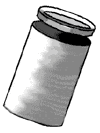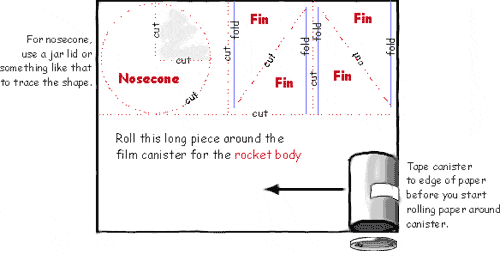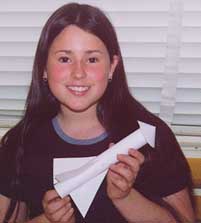Build a Bubble-Powered Rocket!

Build your own rocket using paper and fizzing tablets! Watch it lift off. How high does your rocket go? Print this page for the instructions.
Suggestion:
Find a grown-up to do this activity with you.
Materials:
Paper, regular 8-1/2- by 11-inch paper, such as computer printer paper or even notebook paper.
Plastic 35-mm film canister (see hints below)
Cellophane tape
Scissors
Effervescing (fizzing) antacid tablet (the kind used to settle an upset stomach)
Paper towels
Water
Eye protection (like eye glasses, sun glasses, or safety glasses)
Hints:

The film canister MUST be one with a cap that fits INSIDE the rim instead of over the outside of the rim. Sometimes photography shops have extras of these and will be happy to donate some for such a worthy cause.
Keep in mind:
Just like with real rockets, the less your rocket weighs and the less air resistance (drag) it has, the higher it will go.
Making the Rocket
You must first decide how to cut your paper. You may cut it the short way or the long way to make the body of the rocket. There is no one right way to make a paper rocket. Try a long, skinny rocket or a short, fat rocket. Try a sharp nosecone or a blunt nosecone. Try it with fins or without fins. Experiment!
Here's just one idea for how you might cut your whole rocket from one piece of paper:

Here are the basic steps:
Cut out all the pieces for your rocket.
Wrap and tape a tube of paper around the film canister. Hint: Tape the canister to the end of the paper before you start wrapping.
Important! Place the lid end of the canister down.
Tape fins to your rocket body, if you want.
Roll the circle (with a wedge cut out) into a cone and tape it to the rocket's top.
Blasting Off
Put on your eye protection.
Turn the rocket upside down and remove the canister's lid.
Fill the canister one-third full of water.
Now work quickly on the next steps!
Drop one-half of an effervescing antacid tablet into the canister.
Snap the lid on tight.
Stand your rocket on a launch platform, such as your sidewalk or driveway.
Stand back and wait. Your rocket will blast off!

So, Dr. Marc, how does the pop-rocket work?
When the fizzy tablet is placed in water, many little bubbles of gas escape. The bubbles go up, instead of down, because they weigh less than water. When the bubbles get to the surface of the water, they break open. All that gas that has escaped from the bubbles pushes on the sides of the canister.
Now when you blow up a balloon, the air makes the balloon stretch bigger and bigger. But the little film canister doesn't stretch and all this gas has to go somewhere!
Eventually, something has to give! So the canister pops its top (which is really its bottom, since it's upside down). All the water and gas rush down and out, pushing the canister up and up, along with the rocket attached to it.
We call this wonderful and useful fact the law of action and reaction. The action is the gas rushing out of the rocket. The reaction is the rocket taking off in the other direction. In other words, for every action there is an equal and opposite reaction. The rocket goes in the opposite direction from the gas, and the faster the gas leaves the rocket, the faster the rocket gets pushed the other way.
Comments
Post a Comment